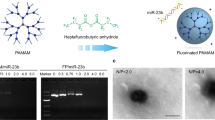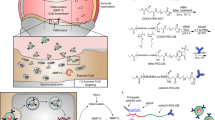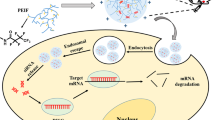Abstract
Dupuytren disease (DD) is a progressive fibrous proliferative disease. It invades the palmar aponeurosis and extends to the finger fascia, eventually leading to flexion contracture of the metacarpophalangeal or interphalangeal joint. At present, surgical resection and the local injection of collagenase are the main methods for the treatment of DD, but postoperative complications and high recurrence rates often occur. Bioinformatics analysis showed that the increased expression of SFRP4 protein was closely related to the incidence of DD. Persistent and effective inhibition of SFRP4 expression may be a promising treatment for DD. We prepared SFRP4 siRNA/nanoparticle complexes (si-SFRP4) and negative siRNA/nanoparticle complexes (NC) and applied them in vitro and in vivo. Flow cytometry analysis showed that si-SFRP4 could be successfully transfected into DD cells. MTT and EdU staining assays showed that the OD values and percentage of EdU-positive cells in the si-SFRP4 group were significantly lower than those in the NC group. Scratch tests showed that the wound healing rate of the si-SFRP4 group was lower than that of the NC group, and the difference was statistically significant. The expression of SFRP4 and α-SMA protein in the si-SFRP4 group significantly decreased in both DD cells and xenografts. Compared with the NC group, the xenograft quality of the si-SFRP4 group was significantly reduced. Masson’s trichrome staining showed that the collagen and fibrous cells in the si-SFRP4 group were more uniform, slender, parallel and regular. The above experimental results suggest that the proliferation and metabolism of palmar aponeurosis cells and the quality of metacarpal fascia xenografts were both significantly decreased. We speculated that nanoparticle-mediated SFRP4 siRNA can be used as a potential new method for the treatment of DD.
This is a preview of subscription content, access via your institution
Access options
Subscribe to this journal
Receive 12 print issues and online access
$259.00 per year
only $21.58 per issue
Buy this article
- Purchase on Springer Link
- Instant access to full article PDF
Prices may be subject to local taxes which are calculated during checkout





Similar content being viewed by others
Data availability
The datasets generated during and/or analyzed during the current study are available in the [NCBI] repository, [https://www.ncbi.nlm.nih.gov/sra]. The additional data generated during and analyzed during the current study are available from the corresponding author on reasonable request.
References
Wagner P, Román JA, Vergara J. Enfermedad de Dupuytren: revisión [Dupuytren disease]. Rev Med Chil. 2012;140:1185–90.
Leibovic SJ. Normal and pathologic anatomy of Dupuytren disease. Hand Clin. 2018;34:315–29.
Rehman S, Goodacre R, Day PJ, Bayat A, Westerhoff HV. Dupuytren’s: a systems biology disease. Arthritis Res Ther. 2011;13:238.
Khashan M, Smitham PJ, Khan WS, Goddard NJ. Dupuytren’s disease: review of the current literature. Open Orthop J. 2011;5:283–8.
Lam WL, Rawlins JM, Karoo RO, Naylor I, Sharpe DT. Re-visiting Luck’s classification: a histological analysis of Dupuytren’s disease. J Hand Surg Eur Vol. 2010;35:312–7.
Townley WA, Baker R, Sheppard N, Grobbelaar AO. Dupuytren’s contracture unfolded. BMJ. 2006;332:397–400.
Rayan GM. Dupuytren’s disease: anatomy, pathology, presentation, and treatment. Instr Course Lect. 2007;56:101–11.
Chen NC, Srinivasan RC, Shauver MJ, Chung KC. A systematic review of outcomes of fasciotomy, aponeurotomy, and collagenase treatments for Dupuytren’s contracture. Hand. 2011;6:250–5.
van Rijssen AL, Ter Linden H, Werker PMN. Five-year results of a randomized clinical trial on treatment in Dupuytren’s disease: percutaneous needle fasciotomy versus limited fasciectomy. Plast Reconstr Surg. 2012;129:469–77.
Becker GW, Davis TR. The outcome of surgical treatments for primary Dupuytren’s disease–a systematic review. J Hand Surg Eur Vol. 2010;35:623–6.
Balaguer T, David S, Ihrai T, Cardot N, Daideri G, Lebreton E. Histological staging and Dupuytren’s disease recurrence or extension after surgical treatment: a retrospective study of 124 patients. J Hand Surg Eur Vol. 2009;34:493–6.
Bulstrode NW, Jemec B, Smith PJ. The complications of Dupuytren’s contracture surgery. J Hand Surg Am. 2005;30:1021–5.
Citron ND, Nunez V. Recurrence after surgery for Dupuytren’s disease: a randomized trial of two skin incisions. J Hand Surg Br. 2005;30:563–6.
Hurst LC, Badalamente MA, Hentz VR, Hotchkiss RN, Kaplan FT, Meals RA, et al. Injectable collagenase clostridium histolyticum for Dupuytren’s contracture. N Engl J Med. 2009;361:968–79.
Badalamente MA, Hurst LC. Enzyme injection as nonsurgical treatment of Dupuytren’s disease. J Hand Surg Am. 2000;25:629–36.
Badalamente MA, Hurst LC. Efficacy and safety of injectable mixed collagenase subtypes in the treatment of Dupuytren’s contracture. J Hand Surg Am. 2007;32:767–74.
Badalamente MA, Hurst LC, Hentz VR. Collagen as a clinical target: nonoperative treatment of Dupuytren’s disease. J Hand Surg Am. 2002;27:788–98.
Larsen S, Krogsgaard DG, Aagaard Larsen L, Iachina M, Skytthe A, Frederiksen H. Genetic and environmental influences in Dupuytren’s disease: a study of 30,330 Danish twin pairs. J Hand Surg Eur Vol. 2015;40:171–6.
Capstick R, Bragg T, Giele H, Furniss D. Sibling recurrence risk in Dupuytren’s disease. J Hand Surg Eur Vol. 2013;38:424–9.
Ten Dam EJ, van Beuge MM, Bank RA, Werker PM. Further evidence of the involvement of the Wnt signaling pathway in Dupuytren’s disease. J Cell Commun Signal. 2016;10:33–40.
Kang YM, Choi YR, Yun CO, Park JO, Suk KS, Kim HS, et al. Down-regulation of collagen synthesis and matrix metalloproteinase expression in myofibroblasts from Dupuytren nodule using adenovirus-mediated relaxin gene therapy. J Orthop Res. 2014;32:515–23.
Chisholm J, Gareau AJ, Byun S, Paletz JL, Tang D, Williams J, et al. Effect of compound 21, a selective angiotensin II type 2 receptor agonist, in a murine xenograft model of Dupuytren disease. Plast Reconstr Surg. 2017;140:686e–96e.
Wu YX, Liang P, Dong QM, Bai Y, Yu Z, Huang J, et al. Design of a silver nanoparticle for sensitive surface enhanced Raman spectroscopy detection of carmine dye. Food Chem. 2017;237:974–80.
Sun N, Johnson J, Stack MS, Szajko J, Sander C, Rebuyon R, et al. Nanoparticle analysis of cancer cells by light transmission spectroscopy. Anal Biochem. 2015;484:58–65.
Wang H, Xie C, Zhang W, Cai S, Yang Z, Gui Y. Comparison of dye degradation efficiency using ZnO powders with various size scales. J Hazard Mater. 2007;141:645–52.
Grabowska M, Grześkowiak BF, Rolle K, Mrówczyński R. Magnetic Nanoparticles as a Carrier of dsRNA for Gene Therapy. Methods Mol Biol. 2021;2211:69–81.
Padilha AC, Vivas MG, Melo MDSF, Campos MGN. Fluorescent chitosan nanoparticles as a carrier system for trackable drug delivery. Polym Plast Technol Mater. 2021;60:862–71.
Yousefi Aldashi S, Saffari Z, Ebrahimi Shahmabadi H, Akbarzadeh A. In vitro assessment of magnetic liposomal paclitaxel nanoparticles as a potential carrier for the treatment of ovarian cancer. Adv Pharm Bull. 2021;11:267–73.
Shen J, Zhao DJ, Li W, Hu QL, Wang QW, Xu FJ, et al. A polyethylenimine-mimetic biodegradable polycation gene vector and the effect of amine composition in transfection efficiency. Biomaterials. 2013;34:4520–31.
Arany S, Benoit DS, Dewhurst S, Ovitt CE. Nanoparticle-mediated gene silencing confers radioprotection to salivary glands in vivo. Mol Ther. 2013;21:1182–94.
Chung YC, Hsieh WY, Young TH. Polycation/DNA complexes coated with oligonucleotides for gene delivery. Biomaterials. 2010;31:4194–203.
Davis ME, Zuckerman JE, Choi CH, Seligson D, Tolcher A, Alabi CA, et al. Evidence of RNAi in humans from systemically administered siRNA via targeted nanoparticles. Nature. 2010;464:1067–70.
Delgado D, Gascón AR, Del Pozo-Rodríguez A, Echevarría E, Ruiz de Garibay AP, Rodríguez JM, et al. Dextran-protamine-solid lipid nanoparticles as a non-viral vector for gene therapy: in vitro characterization and in vivo transfection after intravenous administration to mice. Int J Pharm. 2012;425:35–43.
Wong SP, Argyros O, Harbottle RP. Vector systems for prenatal gene therapy: principles of non-viral vector design and production. Methods Mol Biol. 2012;891:133–67.
Yang QQ, Shao YX, Zhang LZ, Zhou YL. Therapeutic strategies for flexor tendon healing by nanoparticle-mediated co-delivery of bFGF and VEGFA genes. Colloids Surf B Biointerfaces. 2018;164:165–76.
Zhou YL, Yang QQ, Yan YY, Zhang L, Wang QH, Ju F, et al. Gene-loaded nanoparticle-coated sutures provide effective gene delivery to enhance tendon healing. Mol Ther. 2019;27:1534–46.
Abe Y, Rokkaku T, Ofuchi S, Tokunaga S, Takahashi K, Moriya H. Surgery for Dupuytren’s disease in Japanese patients and a new preoperative classification. J Hand Surg Br. 2004;29:235–9.
Dolmans GH, Werker PM, Hennies HC, Furniss D, Festen EA, Franke L, et al. Wnt signaling and Dupuytren’s disease. N Engl J Med. 2011;365:307–17.
Degreef I, De Smet L, Sciot R, Cassiman JJ, Tejpar S. Beta-catenin overexpression in Dupuytren’s disease is unrelated to disease recurrence. Clin Orthop Relat Res. 2009;467:838–45.
Bowley E, O’Gorman DB, Gan BS. Beta-catenin signaling in fibroproliferative disease. J Surg Res. 2007;138:141–50.
Shih B, Tassabehji M, Watson JS, Bayat A. DNA copy number variations at chromosome 7p14.1 and chromosome 14q11.2 are associated with dupuytren’s disease: potential role for MMP and Wnt signaling pathway. Plast Reconstr Surg. 2012;129:921–32.
Ng M, Thakkar D, Southam L, Werker P, Ophoff R, Becker K, et al. A genome-wide association study of Dupuytren disease reveals 17 additional variants implicated in fibrosis. Am J Hum Genet. 2017;101:417–27.
Zhang HY, Gharaee-Kermani M, Zhang K, Karmiol S, Phan SH. Lung fibroblast alpha-smooth muscle actin expression and contractile phenotype in bleomycin-induced pulmonary fibrosis. Am J Pathol. 1996;148:527–37.
Lee HW, Park YM, Lee SJ, Cho HJ, Kim DH, Lee JI, et al. Alpha-smooth muscle actin (ACTA2) is required for metastatic potential of human lung adenocarcinoma. Clin Cancer Res. 2013;19:5879–89.
Carpino G, Morini S, Ginanni Corradini S, Franchitto A, Merli M, Siciliano M, et al. Alpha-SMA expression in hepatic stellate cells and quantitative analysis of hepatic fibrosis in cirrhosis and in recurrent chronic hepatitis after liver transplantation. Dig Liver Dis. 2005;37:349–56.
Michalopoulos GK. Liver regeneration after partial hepatectomy: critical analysis of mechanistic dilemmas. Am J Pathol. 2010;176:2–13.
Lomas NJ, Watts KL, Akram KM, Forsyth NR, Spiteri MA. Idiopathic pulmonary fibrosis: immunohistochemical analysis provides fresh insights into lung tissue remodelling with implications for novel prognostic markers. Int J Clin Exp Pathol. 2012;5:58–71.
Holm Nielsen S, Willumsen N, Leeming DJ, Daniels SJ, Brix S, Karsdal MA, et al. Serological assessment of activated fibroblasts by alpha-smooth muscle actin (α-SMA): a noninvasive biomarker of activated fibroblasts in lung disorders. Transl Oncol. 2019;12:368–74.
Gelfand RA, Vernet D, Kovanecz I, Rajfer J, Gonzalez-Cadavid NF. The transcriptional signatures of cells from the human Peyronie’s disease plaque and the ability of these cells to generate a plaque in a rat model suggest potential therapeutic targets. J Sex Med. 2015;12:313–27.
Weiland TL, Gaffey TA. Histology for pathologists. In: Sternberg SS, editor. New York: Raven Press; 1992, p. 977.
Bovolenta P, Esteve P, Ruiz JM, Cisneros E, Lopez-Rios J. Beyond Wnt inhibition: new functions of secreted Frizzled-related proteins in development and disease. J Cell Sci. 2008;121:737–46.
Clevers H, Nusse R. Wnt/β-catenin signaling and disease. Cell. 2012;149:1192–205.
Howard JC, Varallo VM, Ross DC, Roth JH, Faber KJ, Alman B, et al. Elevated levels of beta-catenin and fibronectin in three-dimensional collagen cultures of Dupuytren’s disease cells are regulated by tension in vitro. BMC Musculoskelet Disord. 2003;4:16.
Montgomery E, Folpe AL. The diagnostic value of beta-catenin immunohistochemistry. Adv Anat Pathol. 2005;12:350–6.
Varallo VM, Gan BS, Seney S, Ross DC, Roth JH, Richards RS, et al. Beta-catenin expression in Dupuytren’s disease: potential role for cell-matrix interactions in modulating beta-catenin levels in vivo and in vitro. Oncogene. 2003;22:3680–4.
Vi L, Njarlangattil A, Wu Y, Gan BS, O’Gorman DB. Type-1 collagen differentially alters beta-catenin accumulation in primary Dupuytren’s Disease cord and adjacent palmar fascia cells. BMC Musculoskelet Disord. 2009;10:72.
O’Gorman DB, Wu Y, Seney S, Zhu RD, Gan BS. Wnt expression is not correlated with beta-catenin dysregulation in Dupuytren’s disease. J Negat Results Biomed. 2006;5:13.
Huang D, Yu B, Deng Y, Sheng W, Peng Z, Qin W, et al. SFRP4 was overexpressed in colorectal carcinoma. J Cancer Res Clin Oncol. 2010;136:395–401.
Busuttil RA, George J, House CM, Lade S, Mitchell C, Di Costanzo NS, et al. SFRP4 drives invasion in gastric cancer and is an early predictor of recurrence. Gastric Cancer. 2021;24:589–601.
Vincent KM, Postovit LM. A pan-cancer analysis of secreted Frizzled-related proteins: re-examining their proposed tumour suppressive function. Sci Rep. 2017;7:42719.
Bernreuther C, Daghigh F, Möller K, Hube-Magg C, Lennartz M, Lutz F, et al. Secreted frizzled-related protein 4 (SFRP4) is an independent prognostic marker in prostate cancers lacking TMPRSS2: ERG fusions. Pathol Oncol Res. 2020;26:2709–22.
Suzuki H, Watkins DN, Jair KW, Schuebel KE, Markowitz SD, Chen WD, et al. Epigenetic inactivation of SFRP genes allows constitutive WNT signaling in colorectal cancer. Nat Genet. 2004;36:417–22.
Jones SE, Jomary C. Secreted Frizzled-related proteins: searching for relationships and patterns. Bioessays. 2002;24:811–20.
Liang CJ, Wang ZW, Chang YW, Lee KC, Lin WH, Lee JL. SFRPs are biphasic modulators of Wnt-signaling-elicited cancer stem cell properties beyond extracellular control. Cell Rep. 2019;28:1511–25. e5
Xing SG, Zhou YL, Yang QQ, Ju F, Zhang L, Tang JB. Effects of nanoparticle-mediated growth factor gene transfer to the injured microenvironment on the tendon-to-bone healing strength. Biomater Sci. 2020;8:6611–24.
Bankert RB, Egilmez NK, Hess SD. Human-SCID mouse chimeric models for the evaluation of anti-cancer therapies. Trends Immunol. 2001;22:386–93.
Wu J, Zhang J, Jiang M, Zhang T, Wang Y, Wang Z, et al. Comparison between NOD/SCID mice and BALB/c mice for patient-derived tumor xenografts model of non-small-cell lung cancer. Cancer Manag Res. 2018;10:6695–703.
Giavazzi R, Campbell DE, Jessup JM, Cleary K, Fidler IJ. Metastatic behavior of tumor cells isolated from primary and metastatic human colorectal carcinomas implanted into different sites in nude mice. Cancer Res. 1986;46:1928–33.
Fidler IJ. Critical factors in the biology of human cancer metastasis: twenty-eighth G.H.A. Clowes memorial award lecture. Cancer Res. 1990;50:6130–38.
Zhou B, Hua YW, Sheng SJ, Zhang ZD, Wan BS. Tumor formation of gastrointestinal stromal tumor tissue in different parts of nude mice aged different weeks. Chinese J Tiss Eng Res. 2011;15:5205–9.
Leimeister C, Bach A, Gessler M. Developmental expression patterns of mouse sFRP genes encoding members of the secreted frizzled related protein family. Mech Dev. 1998;75:29–42.
Becker K, Tinschert S, Lienert A, Bleuler PE, Staub F, Meinel A, et al. The importance of genetic susceptibility in Dupuytren’s disease. Clin Genet. 2015;87:483–7.
Acknowledgements
This work was financially supported by Technology Projects of Nantong (No. MS12019022).
Funding
This study was funded by Technology Projects of Nantong (No. MS12019022).
Author information
Authors and Affiliations
Contributions
All authors were responsible for conceiving and designing the review protocol, acquiring and analyzing data, interpreting results. RJJ and WGZ were responsible for conducting the search, drafting the manuscript and updating reference lists. ADD and JHG were responsible for revising the report. All authors approved the final version and agreed to be accountable for all aspects of the work.
Corresponding authors
Ethics declarations
Competing interests
The authors declare no competing interests.
Additional information
Publisher’s note Springer Nature remains neutral with regard to jurisdictional claims in published maps and institutional affiliations.
Supplementary information
Rights and permissions
About this article
Cite this article
Jin, R., Zhu, W., Xu, J. et al. Effect of nanoparticle-mediated delivery of SFRP4 siRNA for treating Dupuytren disease. Gene Ther 30, 31–40 (2023). https://doi.org/10.1038/s41434-022-00330-9
Received:
Revised:
Accepted:
Published:
Issue Date:
DOI: https://doi.org/10.1038/s41434-022-00330-9



